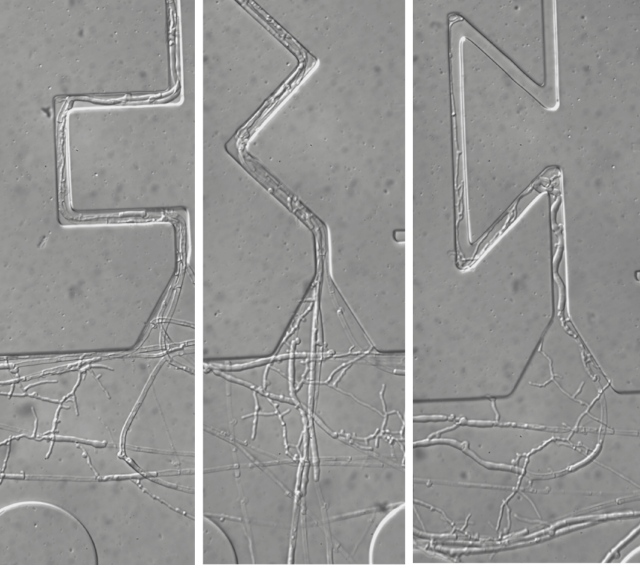When you think of fungi, you’ll probably picture a huddle of chubby brown mushrooms, or the large, red-capped toadstools you stumble across in the woods. In doing so, you’re reducing fungi to their reproductive organs – tasty or striking as they may often be.
The main body of a fungus is actually a large interwoven network called the mycelium, which consists of incredibly thin fungal tubes called hyphae. These hyphae are a bit like plant roots: they grow into soil, unseen by us humans, on the hunt for nutrients.
Our recent research used an artificial fungal obstacle course to spy on hyphal growth and behaviour. We found a remarkable variety of growth strategies employed by fungal hyphae – so many that we had to give them names.
From the brute force of the “zombie”, which breaks through physical barriers, to the intrepid “marathon runner”, who sets off way ahead of the pack to explore, fungal hyphae appear to be ingenious subterranean foragers. And our findings aren’t merely fascinating: they may have important implications for our fight against climate change, too.
Foraging fungi
Fungi are fascinating organisms. Neither plants nor animals, they belong to their own distinct kingdom, estimated to be composed of between 2 and 6 million species. And though they may look very different from us, fungi still – like us – have to find ways to locate food and solve problems in their environment.
Fungi are also crucial for all nutrient cycles. They decompose and recycle dead biomass in the environment, and help feed water and nutrients to the roots of about 90% of all land plants. They can be a pain, too: they can cause diseases in humans, animals and plants, and destroy huge amounts of agricultural produce.
Read more: Complex life may only exist because of millions of years of groundwork by ancient fungi
Integral to fungi are the hyphae: tubes so thin that sometimes they’re not even visible to the naked eye. For reference, a human hair is about 50 micrometres wide, while fungal hyphae often are as thin as 2 or 3 micrometres.

Going underground
Many fungi live most of their lives underground, out of sight. As such, we know very little about how these organisms experience their underground environment: if they have the ability to feel that there is food nearby, or what strategies they use to find it.
This was a challenge that we wanted to tackle. Together with biomedical engineers, we manufactured a transparent system of microscopic tunnels that allowed us to simulate the structures found in soil. These “soil chips” are effectively obstacle courses designed to put fungal hyphae through their paces on their search for food.

In plant ecology, clonal plant roots are said to grow either like a phalanx unit (short and very densely) or a guerrilla army (far but sparsely). We were surprised to find this dichotomy unusable for our fungi: we needed many more categories.
So, we gave the fungi nicknames to reflect their different growth strategies. Some species had hyphae that grew dense but very far and very straight, without exploring their surroundings (“the marathon runner”).
Others progressed slowly but constantly for months, meandering past complicated turns and corners (“the snake”). Others still branched heavily, filled up almost all free spaces, and with incredible force broke themselves through solid parts of the chips (“the zombie”).

Foraging strategies
These distinct fungal strategies are probably evolutionary traits, given the diversity of environments that the different fungi might encounter. Dense growth strategies allow fungi to break down complex food sources that require large concentrated amounts of enzymes, while far-reaching exploration strategies help fungi to more quickly locate more ephemeral food sources that are spread out or far away.
We also found certain situations that gave fungi a hard time. For example, repeated sharp turns led some to get stuck in corners. Others lost their sense of direction after growing around a circular obstacle.

We were especially interested in those obstacles that hindered fungal growth. That’s because soils are the Earth’s largest terrestrial carbon reservoir, and small changes in their carbon cycling could generate huge differences for atmospheric CO₂ levels. Understanding how soil structures impact fungal growth may lead us to understand how to optimise soils for carbon sequestration – helping us store more CO₂ in the ground.
For now, we hope that our soil chips can continue to be used to spy on the secret life of fungi. Our study only looked at seven different litter-decomposing species of fungi, so there’s plenty of scope for new findings that could reveal how the foraging of fungi underground might affect ecosystems above it.

